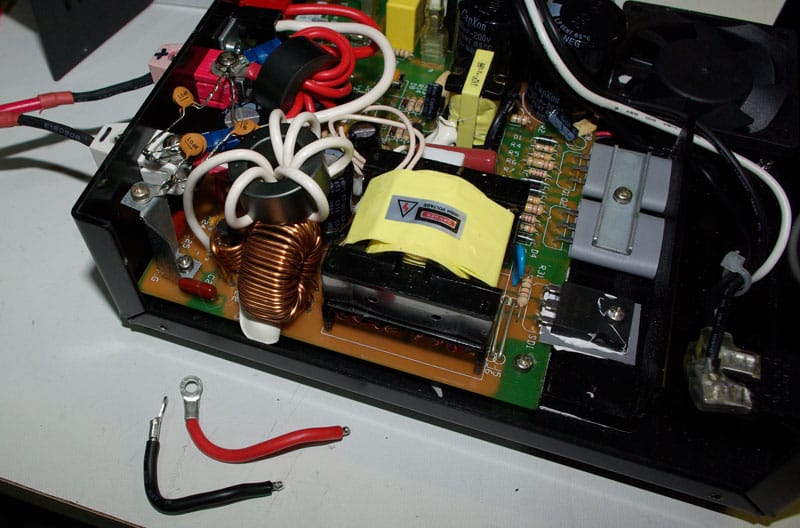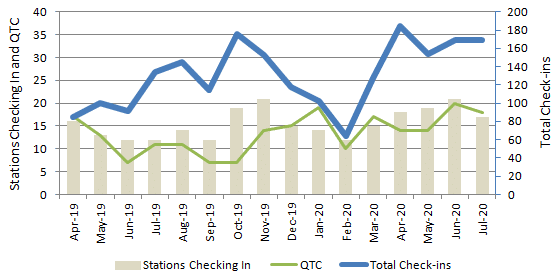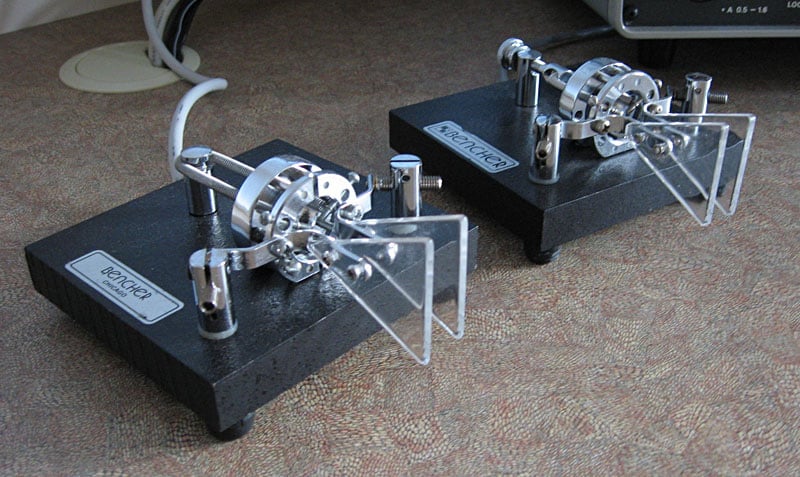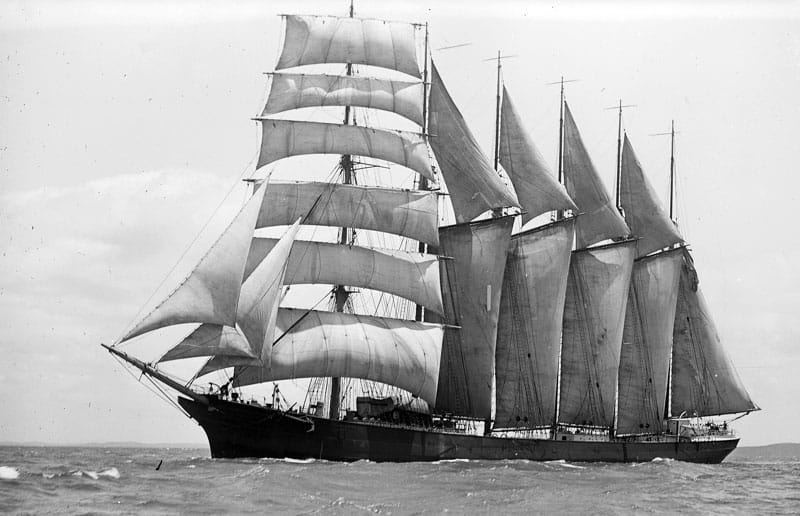This is a fortnightly newsletter about the New Zealand Net.
If you would like to be notified by email message when a new edition is published, please contact ZL1NZ.
You are also welcome to browse our newsletter archive.
Radio operator: 1, Noise: 0

By Gerard ZL2GVA
I had bad QRM close to 3535, but it never occurred to me that it was an ‘internal’ issue. Then, one day I switched off the power supply before the radio, and the QRM just dropped away.
I was using my Samlex 1223 power supply, and found some info on it by ZL2DF. Putting $1.50 worth of 100nF caps and a couple of junk box toroids on the outlet fixed most of the problem.
It all just fits. ZL2DF used ferrite beads which would have been a bit more compact, but I had these bigger cores lying around and went for a few windings on them. This also meant I had to replace the output wires. As you can see in the photo, they are a little bit thinner than the originals but, since I won’t be running this at 23 Amps 100%, I think it’s fine (I actually have never heard the fan go on in this PS).
I can still hear the interference at places, but it doesn’t even raise the S meter. So now I have only QRN and, when that’s not there, the S meter doesn’t move. I’ve been able to pick up fragments of some of the VK stations during the NZ Net.
A horizontal 80m loop may be the next project, but it could be summer before I get around to that.
(Troubled by local QRM? QRM Guru may have some helpful ideas. – Ed.)
Net numbers

July saw 169 check-ins to the Net, exactly the same as the previous month, but with slightly fewer stations (17) and less traffic passed. Here’s the monthly report:
NR 55 R ZL1NZ 43/40 AUCKLAND 0900Z 3AUG20 = NZ NET = JULY QNI ZL1AJY 2 ZL1ANY 15 ZL1BWG 17 ZL1NZ 23 ZL1PC 2 ZL2GD 17 ZL2GVA 9 ZL2LN 8 ZL2WT 18 ZL3RX 1 ZL4CU 9 ZL4FZ 2 ZL4KX 14 ZL4LDY 9 VK2IOW 1 VK3DRQ 19 VK4PN 3 TOTAL 169 QTC 18 = ZL1NZ
August starts strongly
The first week of August has been busy on the Net, with lots of check-ins, and we have handled traffic during every net session, which is a new milestone. Although, we’re not a “traffic net” we’re certainly “a net that handles traffic!” 🙂
Traffic this week was originated by Stephen ZL1ANY (2), Neil ZL1NZ (2) and Grant ZL2GD (1).
Manny VK3DRQ attempted to list traffic for ZL1NZ from Roy VK6RR but conditions were not good, so I checked into the 20m net to get it, and that was a bit of an adventure. The only station I could copy was Peter VK4QC, so he sent me the traffic – but when he got about halfway through we completely lost propagation. After a few minutes, Manny’s signal came up in strength, so he sent me the second part of the message. After a couple of “fills” the job was done. Sometimes it takes perseverance!
For those who didn’t hear Stephen’s QNC this evening, he is interested in making some contacts on 60m, so if you have that band, give him a shout on the Net or send him an email to arrange a QSO.
Story of the Bencher paddles

Bencher BY-1 (dual lever) and ST-1 (single lever) paddles at ZL1NZ
The Bencher BY-1 iambic keyer can be found in thousands of ham shacks around the world. But there’s a lot about these iconic paddles that I only learned recently.
For example:
- The BY-1 evolved from something called an FYO keyer.
- The single-lever ST-1 version actually came after the dual-lever BY-1 (due to patent protection on the original design).
There’s a lot of interesting history in this 1992 article from Morsum Magnificat [PDF], written by Bob Locher W9KNI, who was owner of Bencher at the time. The company was bought by Vibroplex in 2015.
World’s most boring job?
When I listen to South Korean coast radio stations, such as HLW, endlessly calling CQ, I sometimes wonder: “Is there really an operator there, headphones on, listening for a call?”.
Maybe a ship does occasionally call them, but I’ve never yet heard the CQ wheel stop. Then again, it’s not the sort of thing I want to listen to for a long time!
Have you ever heard them answer a call?
The recording above is of HLW on 8636.0 kHz, 30 July 2020.
Maritime mobile

Barquentine ER Sterling, probably at Auckland. Date unknown. Photo: James Hutching Kinnear
The majestic American barquentine ER Sterling was a frequent visitor to Auckland for about ten years following World War One, carrying general cargo and timber.
She was mentioned in newspaper shipping columns when she was within wireless range of the Awanui, Auckland, Wellington and Chatham Islands stations.
In this photo, some of the spreaders for her wireless aerial can be seen at the tops of the masts.
ER Sterling was built of iron in 1883 at Harland & Wolffe in Belfast, and you can read more about her interesting history here.
Scrambled signals
Have you ever noticed that people denote Morse prosigns in different ways? For example, the “end-of-work” signal is written by some people as <SK> but by other people as <VA> but I’ve never seen anyone write it as <VET>.
It’s not because prosigns are always represented as two letters. The question mark (repeat signal) is customarily written as three letters <IMI>. Perhaps that’s because it reflects the symmetry of the sound.
Anyway, with that introduction, it’s time for our latest NZ Net News game (oh no!).

Send me an email with the meaning of this prosign: <VGI> and the first correct answer will get one of these!
(That’s right, a photo of a chocolate fish.)
Net tip: Asking for a fill
This is a topic we’ve mentioned before, but I’d like to revisit it, as some of the newer Net members may not be aware of how to ask for a fill after copying a piece of formal traffic (a radiogram).
BN [word A] [word B] means “Re-send all between [word A] and [word B] including those two words”
WA [word] means “Re-send [word], and the word after it”
WB [word] means “Re-send the word before and [word]”
AA [word] means “Re-send [word] and all after it (right up to <AR>)”
AB [word] means “Re-send all before (right from the opening <CT>) and including [word]”
So, if you ask for an AA or an AB you are likely to get a LOT of material repeated, and chances are you don’t actually need all of that.
My recommendation is to consider using BN if you only missed a portion of the message.
Other options are possible if they are brief and easily understood. For example, if you missed the Check numbers, just send CK? or if you missed the address, send ADR?
Suggestions?
If you have suggestions on how to make the NZ Net better, or things you’d like to see covered in these updates, please contact ZL1NZ. You might even like to write something for the newsletter.
Thanks for reading, and I hope to see you soon on the NZ Net!
—
Neil Sanderson ZL1NZ, Net Manager
New Zealand Net (NZ NET)
3535.0 kHz at 9pm NZT Mon-Fri


